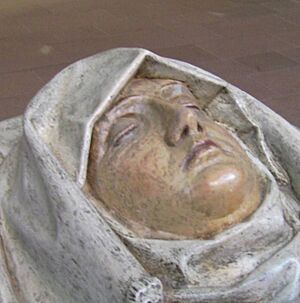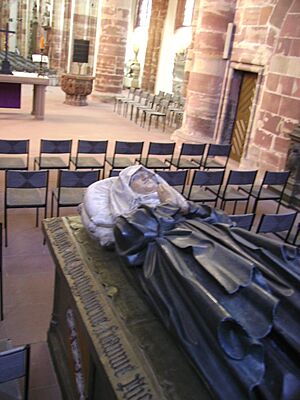Elisabeth of Lorraine-Vaudémont facts for kids
Quick facts for kids
Elisabeth of Lorraine-Vaudémont
|
|
|---|---|

Elisabeth of Lorraine-Vaudémont
|
|
| Born | c. 1395 Lorraine |
| Died | 17 January 1456 Saarbrücken |
| Buried | Collegiate Church in Sankt Arnual |
| Noble family | House of Lorraine |
| Spouse(s) | Philipp I, Count of Nassau-Weilburg |
| Father | Frederick I, Count of Vaudémont |
| Mother | Margaret of Joinville |
Elisabeth of Lorraine-Vaudémont (born around 1395, died 1456) was an important German noblewoman. She was known for being a regent, which means she ruled a territory for her young son. She was also a pioneer in writing and translating stories. Elisabeth helped bring French adventure stories into the German language. She translated these tales, called "chansons de geste," into Early New High German. This was a big step for novels in Germany.
Contents
Life of Elisabeth
Elisabeth was born around 1395 in Lorraine. Her father was Frederick of Lorraine. Her mother was Margaret of Joinville. In 1412, Elisabeth married Count Philip I of Nassau-Weilburg-Saarbrücken. She was his second wife.
Elisabeth's Time as Regent
After her husband, Count Philip I, died in 1429, Elisabeth became a regent. This meant she ruled the County of Nassau-Weilburg. She ruled for her son, Philip II, because he was too young to rule himself. She was regent from 1429 until 1438.
The territory she ruled included areas along the Saar and Blies rivers. It also covered parts of eastern Lorraine and the Taunus area. Elisabeth was very good at keeping her lands safe. She avoided fights with neighboring rulers. During her rule, Saarbrücken became an important city. It was the main place where the rulers lived and worked. She lived at Saarbrücken Castle. Before her, rulers often traveled a lot to show their power. Elisabeth helped create a more central way of governing.
Elisabeth's Death and Burial
Elisabeth died on January 17, 1456, in Saarbrücken. Most of the old Counts of Saarbrücken were buried in Wadgassen. But Elisabeth chose to be buried in the Collegiate Church in Sankt Arnual. This church is now part of Saarbrücken. For the next 200 years, many other Counts of Nassau-Saarbrücken were also buried there.
Elisabeth's Legacy
Elisabeth planned her inheritance carefully. In 1439, she divided her lands between her two sons. Her older son, Philip II, received the lands on the right side of the Rhine River. Her younger son, John II, received the lands on the left side.
John II was very interested in his mother's writing. He had beautiful copies made of the novels she translated. Today, these old books can be found in important libraries. Some are in the Herzog August Library in Wolfenbüttel. Others are in the State and University Library in Hamburg.
In 2007, an exhibition about Elisabeth's novels was held in Saarbrücken. This was part of a big cultural event. A meeting of European writers also took place in Saarbrücken. Its motto was "Ir herren machent fryden." This is how Elisabeth began her translations.
Family and Children
Elisabeth was the second wife of Count Philip I of Nassau-Weilburg-Saarbrücken. They had several children together:
- Philip II of Nassau-Weilburg
- John II of Nassau-Saarbrücken
- Johannetta (died 1481), who married Count George I of Henneberg
- Margarete (born 1426, died 1490), who married Gerhard of Rodemachern



